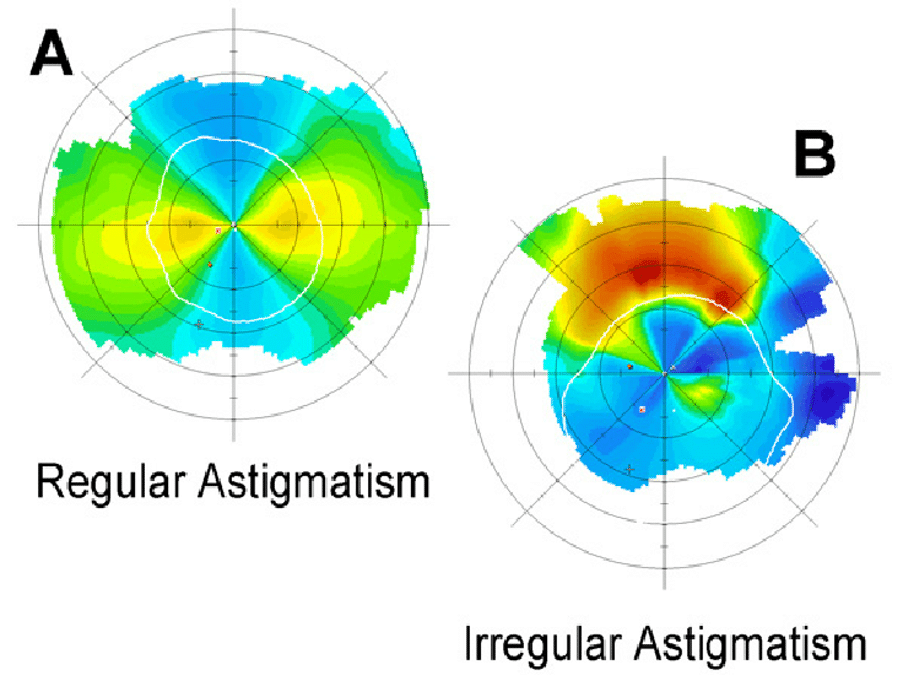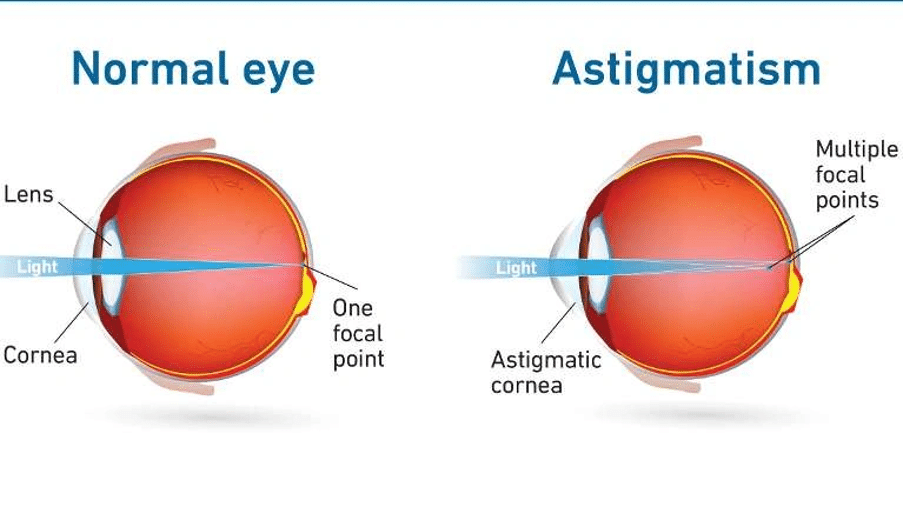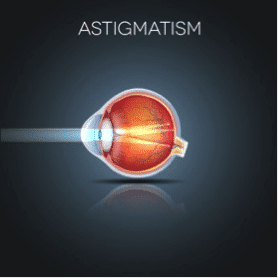Astigmatism is a common refractive error that makes the eye shaped more like a rugby ball than a football. This shape causes irregular focus and blurry vision no matter the distance. The eye’s imperfect curvature stops light from focusing correctly on the retina, which is the light-sensitive layer at the back of the eye.
People with normal vision have a cornea (the clear front surface of the eye) and lens with matching curves. These curves bend incoming light evenly to create sharp focus on the retina. But people with astigmatism have either a cornea or lens (sometimes both) with mismatched curves. The surface looks more like an egg or oval instead of having one smooth curve like a round ball. Light rays don’t bend evenly, which creates two different images that overlap and blur vision.
The eye can have two main types of astigmatism. The first affects the cornea with mismatched curves, while the second develops in the eye’s lens with irregular curves. Both create similar vision problems, though they start in different parts of the eye.

Light behaves differently in an astigmatic eye because of its irregular shape. It bends unevenly and focuses at multiple points. This disrupts the eye’s visual relay system. Light should pass through the cornea, focus through the lens, and create signals for the retina. The retina turns these light signals into electrical ones that travel to the brain through the optic nerve. Astigmatism interferes with this whole process.
Vision problems can show up horizontally, vertically, or diagonally. Objects might look blurry or warped because only parts stay in focus. These distortions happen whatever the viewing distance might be. Most cases of astigmatism start in early childhood or during teenage years. Almost everyone has a small degree of astigmatism, though not all need correction. Many people have it along with other vision problems like short-sightedness (myopia) or long-sightedness (hyperopia).
The condition might lead to lazy eye (amblyopia) if it affects just one eye. This happens because vision doesn’t develop properly. That’s why finding and fixing it early matters, especially for children. The unique shape of an astigmatic eye helps explain its effects on vision and the need for specific corrections. Instead of creating one clear focal point like normal eyes, this irregular curve creates multiple focal points.
How Eye Shape Affects Vision in Astigmatism
An eye with astigmatism has an irregular shape that changes how light enters and focuses inside it. Normal eyes have corneas and lenses with evenly curved surfaces that bend incoming light rays uniformly. This creates a single focal point exactly on the retina. The astigmatic eye can’t focus light correctly because of its unusual curvature.
Light that enters an astigmatic eye bends unevenly when passing through the cornea or lens. The eye’s surface curves more steeply in one direction compared to another. A normal eye is shaped like a baseball and focuses light uniformly. The astigmatic eye looks more like a football or rugby ball and creates two focal points instead of one. This irregular optical setup means only parts of an object stay in focus at once. Light can’t focus properly on the retina, which compromises the visual system. The brain gets mixed signals – some parts of what you see are clear while others stay blurry. Your retina still changes light into electrical signals, but these signals contain distorted information that your brain tries to make sense of.

Looking through a warped window best describes the optical effect. Straight lines might look bent, objects can appear stretched or compressed, and vision lacks sharpness at every distance. Astigmatism creates visual distortion whatever the viewing distance. This happens because the main issue exists in how light gets processed before it reaches the retina. Astigmatism can show blurred vision differently based on where the cornea’s irregularity lies – horizontal, vertical, or diagonal. Some people might see vertical lines clearer than horizontal ones, or the opposite, depending on their specific curvature problem.
Astigmatism causes more than just blurry vision. People often feel eye strain or fatigue, especially after focusing for long periods. The visual system constantly tries to fix these distorted images, which leads to strain. These ongoing visual efforts usually cause headaches. You might also have trouble seeing at night or notice glare around lights, which becomes really obvious when driving after dark. Kids with untreated astigmatism often struggle to read and concentrate. When it affects just one eye severely, the brain might start favouring the good eye, which can lead to amblyopia (lazy eye). That’s why catching and correcting astigmatism early matters so much, especially in young kids whose vision is still developing.
Types of Astigmatism Eye Shape
Astigmatism classifications depend on the eye part that shows irregular curvature and its pattern. These differences help doctors determine the right treatment approach.
Corneal astigmatism
The cornea’s abnormal shape causes corneal astigmatism. This clear front surface of the eye has a curvature that varies in different meridians. The cornea takes on an egg-shaped or football-like appearance instead of its normal spherical form. This represents the most common form of astigmatism. Light rays focus incorrectly due to the irregular corneal surface and create visual distortion. The eye’s natural growth usually leads to corneal astigmatism, though injuries can also cause it. The cornea handles about two-thirds of the eye’s focusing power, so even minor shape irregularities can substantially affect vision quality.
Lenticular astigmatism
The eye’s internal lens develops mismatched curves or irregular shapes in lenticular astigmatism. This condition affects the internal crystalline lens rather than the outer corneal surface. Age-related changes and cataracts often lead to lenticular astigmatism. The lens shape changes as cataracts develop and can create or worsen existing astigmatism. Some patients have both corneal and lenticular astigmatism, which makes visual disturbances more severe.

Regular vs irregular astigmatism
Regular astigmatism shows principal meridians that stay perpendicular to each other—exactly 90° apart. Each meridian maintains uniform curvature across the entire cornea or lens. This type creates predictable visual distortion patterns. Regular astigmatism includes “with-the-rule” (vertical meridian steeper, common in children), “against-the-rule” (horizontal meridian steeper, common in elderly), or “oblique” (principal meridians at angles between 30°-60° and 120°-150°).
Principal meridians that aren’t perpendicular characterise irregular astigmatism. The cornea’s or lens’s curvature changes inconsistently at different points. Eye injuries, corneal scarring, infections like herpes simplex, or conditions like keratoconus typically cause this type. Standard eyeglasses cannot fully correct the unpredictable visual distortions from irregular astigmatism. Every eye has some degree of irregular astigmatism across the entire cornea, but clinically relevant cases remain rare.
How Astigmatism is Diagnosed
Eye care professionals need to perform detailed eye examinations to diagnose astigmatism. A combination of specialised tests helps identify the presence, type, and severity of astigmatism’s eye shape abnormalities.
Visual acuity test
The visual acuity test is the original screening method that identifies potential astigmatism. This basic test measures how well you see letters or symbols from a specific distance. You’ll read from a letter chart placed at a set distance, first with your current eyeglasses (if applicable) and then without them. The test establishes your visual acuity measurement (such as 20/40 or 20/20) and helps determine astigmatism’s severity or other refractive errors. Your results create a baseline for vision quality and show if you need more tests.
Keratometry and corneal topography
A keratometer measures your cornea’s curvature during keratometry. This device assesses the steepest and flattest meridians of the cornea and reveals irregularities that might cause astigmatism. Corneal topography creates a detailed map of the entire corneal surface. Modern devices like the Pentacam system give highly accurate measurements of flat (Kf) and steep (Ks) keratometry readings. The difference between these readings (Ks minus Kf) shows the corneal astigmatism value. These technologies are vital for diagnosing corneal astigmatism and can detect subtle variations in corneal shape.
Refraction and slit lamp exam
Refraction testing determines your exact prescription needs through:
- Automated refraction using specialised equipment
- Manual refraction where the eye doctor uses different lenses while asking which gives you the clearest vision
The slit lamp examination lets doctors inspect the eye’s anterior structures in detail. Your doctor uses a microscope with a bright light source to examine your cornea, iris, lens, and eyelids. This test is a vital part of identifying structural abnormalities that contribute to astigmatism. The slit lamp also detects signs of other conditions that affect vision.
Solutions for Astigmatism Eye Shape
You have several ways to fix astigmatism eye shape. These range from simple solutions to surgery. Each method tackles the uneven corneal or lens curve differently.
Prescription glasses
Prescription glasses are the most common and available treatment for astigmatism eye shape. These glasses use toric lenses that work against the eye’s uneven curve. The cylindrical part of the lens fixes astigmatism and any other vision problems like nearsightedness or farsightedness. People with astigmatism stronger than 1.0 diopters usually need glasses. The lenses help focus light onto the retina to create clear vision. Anti-reflective coatings help reduce glare and light distortions that people with astigmatism often see when driving at night.
Toric contact lenses
Toric contact lenses give you another way to correct astigmatism eye shape. These lenses are different from regular round contacts because they have two curves that run perpendicular to each other. This design helps fix the rugby ball-shaped cornea you see with astigmatism. The lenses stay in place thanks to special features like thin-thick zones, lens trimming, or weight balancing. You can choose between soft and rigid gas permeable (RGP) lenses. RGP lenses might give you sharper vision, but they take longer to get used to. These lenses come in daily or monthly options.
Laser eye surgery
Laser eye surgery changes your cornea’s shape forever to fix astigmatism. The laser removes tiny amounts of corneal tissue to change your eye’s shape from rugby ball-like to more round. You can get LASIK where doctors create a thin flap on your cornea’s surface, surface laser treatments like PRK, LASEK, TransPRK, or SMILE/SmartSight that use a keyhole approach. The success rate hits 95%, and most patients can drive without glasses afterward. The surgery works well even for bad cases of astigmatism—up to 6 diopters.

Lens replacement surgery
Lens replacement surgery, also called refractive lens exchange (RLE), switches your natural lens with an artificial one. This works best for people over 55 with astigmatism. You can get special toric lenses made just for astigmatism. These lenses have different curves in different directions to fix the irregular shape. Surgeons might also make small cuts in the cornea during surgery to help normalise its shape. Each eye costs between £3,900 and £5,100.
Customised treatment at Precision Vision London
Precision Vision London creates treatment plans that match your needs. They use state-of-the-art tools to measure your eyes exactly. Their surgeons regularly handle tough astigmatism cases, even those with 6 diopters, and get great long-term results. You can choose from laser vision correction, lens replacement with premium lenses, or toric lens implants. Each patient gets a full eye check to find the best treatment for their astigmatism pattern. The clinic uses top equipment and gives detailed aftercare to make sure you get the best results.
Key Takeaways
Understanding astigmatism and its treatment options empowers you to make informed decisions about your vision health and explore the most suitable correction methods for your specific needs.
- Astigmatism occurs when your eye is rugby ball-shaped rather than spherical, causing light to focus at multiple points instead of one clear focal point on the retina.
- The condition affects vision at all distances, creating blurred or distorted images, eye strain, and difficulties with night vision regardless of viewing distance.
- Multiple treatment options exist, from prescription glasses and toric contact lenses to laser surgery and lens replacement, with success rates of 95% for surgical interventions.
- Early diagnosis through comprehensive eye exams is crucial, especially for children, as untreated astigmatism can lead to lazy eye and reading difficulties.
- Even severe astigmatism up to 6 diopters can be effectively corrected with modern surgical techniques, offering patients excellent long-term visual outcomes.
The key to successful astigmatism management lies in proper diagnosis and selecting the right treatment approach based on your lifestyle, age, and severity of the condition.
FAQs
Q1. What causes the irregular eye shape in astigmatism? Astigmatism occurs when the cornea or lens has an irregular curvature, resembling a rugby ball rather than a spherical shape. This can be present from birth, develop during childhood, or result from eye injuries or certain eye conditions.
Q2. How does astigmatism affect vision? Astigmatism causes light to focus at multiple points in the eye instead of a single point on the retina. This results in blurred or distorted vision at all distances, potentially causing eye strain, headaches, and difficulty with night vision.
Q3. Can astigmatism be corrected without surgery? Yes, astigmatism can often be corrected without surgery. Prescription glasses with toric lenses and toric contact lenses are common non-surgical solutions that effectively compensate for the irregular eye shape and improve vision.
Q4. Is it possible to treat severe astigmatism? Absolutely. Even severe cases of astigmatism, up to 6 diopters, can be effectively treated. Advanced surgical techniques like laser eye surgery and lens replacement surgery have high success rates in correcting significant astigmatism.
Q5. How is astigmatism diagnosed? Astigmatism is diagnosed through comprehensive eye examinations. These typically include visual acuity tests, keratometry to measure corneal curvature, corneal topography for detailed mapping, and refraction tests to determine the exact prescription needed for vision correction.
Authors & Reviewer
-
 Olivia: Author
Olivia: AuthorHi, I'm Olivia, a passionate writer specialising in eye care, vision health, and the latest advancements in optometry. I strive to craft informative and engaging articles that help readers make informed decisions about their eye health. With a keen eye for detail and a commitment to delivering accurate, research-backed content, I aim to educate and inspire through every piece I write.

